BRAZILIAN READINGS FOR CHILDREN AND YOUTH: BETWEEN THE READER, THE SCHOOL AND THE MARKET
DOI:
https://doi.org/10.22409/gragoata.v19i37.32994Keywords:
Children literature, Reading, Book industryAbstract
The first Brazilian books for the youth were published in the beginning of the nineteenth century, with didactic purposes. The autonomy of this literature materialized with Monteiro Lobato, in the twenties, also a time of economic and social growth. Since then, the Brazilian children’s literature expands due to the increase of the consumer market, the embracing of policies to encourage reading, purchace and distribution of books by the government, curricula centered on crosscutting issues of collective interest. Consumption of literary works is therefore induced by State and school. That does not mean they are missing the spontaneous production, directly chosen by the readership, or creativity. Brazilian children’s literature throughout its history illustrates characteristics of the genre in which it is included, as the relationship between the preferences of the readership and the directions of the school market, the possibilities of creating beyond the print support, the interaction with other media.
Downloads
Downloads
Published
How to Cite
Issue
Section
License
Authors who publish in Gragoatá agree to the following terms:
The authors retain the rights and give the journal the right to the first publication, simultaneously subject to a Creative Commons license CC-BY-NC 4.0, which allows sharing by third parties with due mention to the author and the first publication by Gragoatá.
Authors may enter into additional and separate contractual arrangements for the non-exclusive distribution of the published version of the work (for example, posting it in an institutional repository or publishing it in a book), with recognition of its initial publication in Gragoatá.

Gragoatá is licensed under a Creative Commons - Attribution-NonCommercial 4.0 International.











